List of miscellaneous sirens: Difference between revisions
m (rgrmblll finally fixed the formatting issue (gosh it was a pain)) |
(Type XX series has been moved by Airinpringles, but this part here was forgotten and not removed, thus was removed here.) |
||
| Line 47: | Line 47: | ||
[[File:Red Mound Siren.jpg|left|thumb|161x161px|The siren in Red Mound, WI.]] | [[File:Red Mound Siren.jpg|left|thumb|161x161px|The siren in Red Mound, WI.]] | ||
A '''directional electromechanical siren''' exists in Red Mound, WI, which is of unknown make or model. The siren uses an 18-port rotor and stator, with the rotor having a ring in the middle. 2 beams are bolted to the front of the stator, covering the stator. The siren is driven by a motor located behind the stator. The motor is likely not original to the siren. The entire assembly is bolted to a large rectangular frame via several support beams. The origins of the siren are unknown; it was likely shop-built by someone who derived inspiration from [[William A. Box Iron Works Co.|Denver]] or [[Sterling Siren Fire Alarm Co.|Sterling]]'s products. The siren is in a deplorable condition, with multiple serious cracks on the stator which would render the siren inoperable without major repairs. It is also badly leaning and may collapse if not remedied soon. | A '''directional electromechanical siren''' exists in Red Mound, WI, which is of unknown make or model. The siren uses an 18-port rotor and stator, with the rotor having a ring in the middle. 2 beams are bolted to the front of the stator, covering the stator. The siren is driven by a motor located behind the stator. The motor is likely not original to the siren. The entire assembly is bolted to a large rectangular frame via several support beams. The origins of the siren are unknown; it was likely shop-built by someone who derived inspiration from [[William A. Box Iron Works Co.|Denver]] or [[Sterling Siren Fire Alarm Co.|Sterling]]'s products. The siren is in a deplorable condition, with multiple serious cracks on the stator which would render the siren inoperable without major repairs. It is also badly leaning and may collapse if not remedied soon. | ||
[[Category:Sirens]] | [[Category:Sirens]] | ||
[[Category:Electromechanical Sirens]] | [[Category:Electromechanical Sirens]] | ||
Revision as of 15:45, 22 November 2024
This list is meant to catalog sirens that do not have enough information about them to warrant a full article being made. These may be given pages if enough new information arises about them or their manufacturers.
List of miscellaneous sirens
"Made in Yugoslavia" sirens
2 known small unbranded vehicular sirens are known to exist with no identifiable manufacturer information, save for voltage and "Made in Yugoslavia" stickers, from which these sirens get their names from. These most likely stem from the same company given their similar characteristics.
B8
The B8 (also written B.8) was a siren produced by a "Signaalapparatenfabriek" of The Hague, ZH. Very little is known about the siren, although according to IG WaSi, they were 7 port, ran on 220 V motors, had a starting current of 0.95 A, and weighed about 6 kg (13.2 lbs). At least 1 B8 was produced sometime in the 1970s and the sirens were discontinued at a later unknown date. Neither any B8 units nor information regarding the company exist.
Colerain sirens
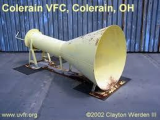
The Colerain sirens are the community-given name of 2 sirens built by the owner of the Messner Bros. workshop in Colerain, OH in the 1980s, which were used for weather warnings. The larger of the two is a large directional siren, making use of a single-tone rotor and stator with a high port count. This was done to create a dual-tone effect. The motor is presumably housed by the large cylindrical assembly behind the siren's horn. The entire siren is held up by several supports beneath the cylindrical assembly and the horn. The smaller of the 2 is an omnidirectional siren, likely making use of a second-hand modified bench grinder, with rotors and stators fitted to each end. The rotors and stators on this siren have a lower port count compared to the larger of the two. Similarly to the larger siren, this was done to create a dual-tone effect. The siren is enclosed in a large rectangular housing. Both of these sirens were removed in 2015 and were presumably scrapped.
Federal Electric plant siren
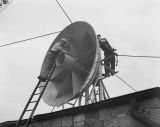
For a short time in the early 1940s, a large directional siren was installed on Federal Electric's manufacturing plant in Chicago, IL, which lacks a known model name and was likely a one-off design. The siren consists of an 8-port rotor and stator and is driven by a motor located behind the siren's large conical projector. The siren's intake is cylindrical and is bolted to the front of the stator. 8 support beams that extend to the back of the projector prevent it from warping out of shape, as its large flimsy design would make it very prone to deforming. This entire assembly is mounted on top of several large beams, and a ladder is included near the siren's rear to allow for maintenance work to be done. A small sign bearing the word "FEDERAL" hangs below the projector, attached by a few ropes tied to one of the siren's mounting beams. Several chains attached to the projector and rear end of the siren hold the entire assembly in place. This design is commonly regarded as a Model 500 prototype, although it came nearly a decade before that siren was introduced and both share very little in common, aside from the relatively similar projector design. Very little is known about this siren; it may have been used as an industrial siren, or as a demonstration, though both of these are speculation and completely unconfirmed. The siren was likely taken down and scrapped soon after it was built, as only 1 image of it is known to exist, dated April 14th, 1942. At the very latest, assuming it stuck around, it could've been removed in the 1950s when the plant was partially demolished to make room for I-94, or 1973, after which the plant was gone entirely.
IntelliSiren
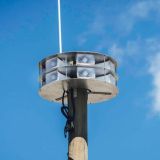
The WeatherCall IntelliSiren is a series of small electronic sirens produced by TechTrol and distributed by WeatherCall Services (who would provide the "activation of the sirens and keep an eye on the location and the warnings issued by the National Weather Service.", according to their website.), introduced in 2020. The sirens are intended for smaller communities and are designed to be as inexpensive as possible, in a similar vein to Custer Electric's sirens. IntelliSirens are as simple as an electronic siren can get, essentially consisting of either 6 or 12 100 W speakers in between circular metal plates shielding the speakers from the elements. 6 or 12 dividers attached to the metal plates are present in between the speakers. The IntelliSiren has mounting legs located on both the top and bottom of the assembly. The sirens can operate via AC or solar power, the most common option. The IntelliSiren activates automatically when the unit is within a tornado polygon, requiring no human interaction, per WeatherCall's website. The siren is programmed to notify a cell phone when a unit is activated or if it fails to activate. As of 2023, the IntelliSiren is only known to have been installed in a few locations, due to being a relatively new siren, with most being installed to replace older inactive sirens. This has caused some controversy with several members of the siren community, arguing that they are poor stand-ins for the sirens they have replaced. Nevertheless, they are claimed to be relatively decent in terms of sound output, though exact ratings are unknown. It remains to be seen how successful the IntelliSiren will be.
WaA38
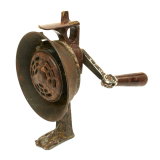
The WaA38 (Waffenamt 38) is a directional hand-powered bakelite siren produced by JURK Sirenenfabrik (or Sirenfabrik), which was a Radeburg, SN-based manufacturer of air raid warning sirens founded by Heino von Amelunxen in 1933. The WaA38 consists of a 7-port rotor and stator and is powered by several gears connected to a retractable hand crank. The gears are enclosed in a housing located behind a frame that connects both it and the rotor and stator assembly to the siren's stand. A large, flared horn covers the rotor and stator, shielding them from the elements and directing the siren's sound forward as well. A cover with several smaller openings is bolted onto the front of the stator to prevent debris from entering the rotor. The WaA38 comes with a shutter mechanism, making use of a stator ring, which covers the ports when a small lever above the stator attached to a return spring beneath the horn is pulled forward. A rectangular hole is cut out from the siren's horn to make room for the lever. A handle is located above the siren for the user to hold while turning the crank. A handful of these sirens exist today, most under private ownership.
Model KIS K6
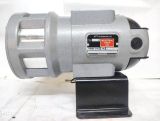
The Model KIS K6, also referred to as simply just the KIS, is a small directional electromechanical industrial siren produced by KPT Industries, a Kolhapur, MH-based electric tool company, and was likely introduced sometime during the early 2000s. The siren is intended for use in industrial areas, indoor use, and short-range outdoor warning. The siren is extremely simple in terms of design, consisting of a small aluminum 5-port rotor and stator driven by a 240 V AC/DC motor. The brushes are visible near the tail end of the motor. The siren's tag is placed on the left side of the motor, held on by 2 screws. The front of the rotor is covered by a cylindrical disc held on by 3 screws, with a screen in the center to prevent potential injury from misuse of the siren, as it is small enough to be handheld. The motor is placed on a horseshoe-shaped stand which has 2 bolts on each end, allowing for the siren to be mounted on a flat surface. The Model KIS K6 weighs around 1.7 kg. According to KPT, the siren can be heard from up to 2 km, depending on where the rotor is facing, as it is a directional siren.
Model LK-ES
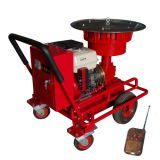
The Model LK-ES is an omnidirectional gas-driven mechanical siren produced by Taizhou Lion King Signal, or simply Lion King, based in the People's Republic of China. The siren was first introduced sometime in the mid-to-late 2000s and was produced until 2021 when it was discontinued by Lion King; it nevertheless continues to be sold by several of Lion King's distributors in southeast Asia. The siren uses the base of a Model LK JDL-400, which consists of a consists of a 10-port rotor and stator with a large, thin rain shield bolted above them, which protects the siren from the elements. A small eyebolt is located above the rain shield. The rotor is rigged to a 13 hp Honda engine which rotates it at 3600 rpm. The engine runs on 93-octane premium-grade gasoline and consumes around 3.3 l of fuel in an hour. A large IP44 enclosure is mounted behind the engine, containing the sire's controls and 2 12 V 17 Ah batteries. The entire assembly is mounted on a cart with 4 wheels, with the assembly being removable. A handle is also attached to the cart. The siren can be activated with a remote control that is included with the siren which has a range of ≤100 meters and allows the siren to perform various signals. The Model LK-ES reaches 128 dB at 1 m (3 ft).
Model No. SI-3
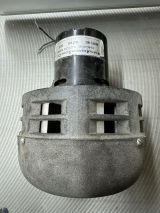
The Model No. SI-3 is a vehicular directional electromechanical siren produced by the North American Signal Company, a Wheeling, IL-based manufacturer of automotive warning lights and accessories, likely from its inception in 1962 to sometime in the late 80s or early 90s. Very few units exist, with most being in the hands of collectors, and not much is known about the siren. The Model No. SI-3 consists of a small 8-port rotor and stator and is driven by a small, 110 V AC motor of unknown horsepower located behind the stator. The motor on the only unit known to exist lacks housing, though it is unclear if this goes for all of these sirens. A simple pedestal mount is located between the stator and motor and allows the siren to be mounted to a flat surface. The ports on the stator have finger guards to prevent injury from misuse of the siren, as it is small enough to be handheld. A large, rounded cover is located in front of the stator, which acts as a finger guard and prevents debris from entering the rotor.
Model VS
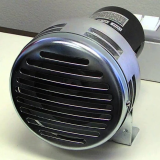
The Model VS, also marketed as Electromechanical Siren, is a small directional electromechanical siren sold under the "Audible Alarms" and "Security" product categories on the Tri Lite website. Working in tandem alongside Tri Lite's Electronic Back-up Alarms, Model VS sirens are intended for use at docks or industrial areas as a form of emergency notification, though also serve a variety of other purposes depending on the buyer's needs. The Model VS sirens are compact and essentially only consist of the required elements of an electromechanical siren; a 6-port rotor and stator, a small bare 12 V DC or 110/115/120 V AC motor (DC units are designated "Model VS1" while AC units are referred to as "Model VS110", regardless of voltage), and a small, chromed L-bracket pedestal mount holding the assembly up. Tiny rectangular stickers with Tri Lite branding and siren information are plastered on top of the motor. DC models draw 6-8 A on start and 4-6 A when operating, while AC models draw 8-10 A on start and 2-3 A when operating. Finger guards on each port and a chromed grill in front of the stator are present to prevent injury from misuse. The siren reaches 101 dB at 10 ft. The Model VS can be operated continuously for 60 seconds; running it any longer could cause the motor to overheat. The siren is 7" long, 5½" wide, and 6½" tall, weighing about 3¾ lbs. The Model VS sirens are sold by several other companies under partnerships with Tri Lite and can usually be found under different model names and branding.
Monmouth siren
wip
Red Mound siren

A directional electromechanical siren exists in Red Mound, WI, which is of unknown make or model. The siren uses an 18-port rotor and stator, with the rotor having a ring in the middle. 2 beams are bolted to the front of the stator, covering the stator. The siren is driven by a motor located behind the stator. The motor is likely not original to the siren. The entire assembly is bolted to a large rectangular frame via several support beams. The origins of the siren are unknown; it was likely shop-built by someone who derived inspiration from Denver or Sterling's products. The siren is in a deplorable condition, with multiple serious cracks on the stator which would render the siren inoperable without major repairs. It is also badly leaning and may collapse if not remedied soon.